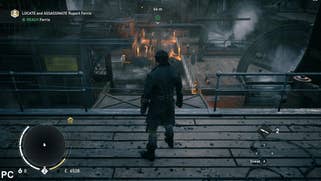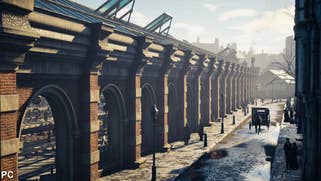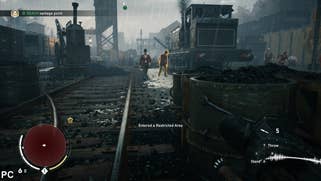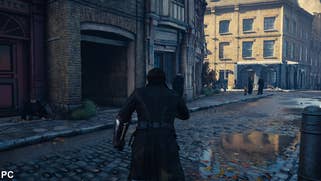Digital Foundry vs Assassin's Creed Syndicate PC
Unity is a high-end PC showcase - does the sequel provide the same transformative upgrade over console?
Is the new generation of console hardware holding back creators from fully realising their visions for next generation visuals? It's a question we've been pondering recently with the release of Assassin's Creed Syndicate. There's no doubt that it's an accomplished title, but stacked up against last year's Unity running fully maxed on PC, there's a sense that it feels like a backward step from a technological perspective.
Of course, the sheer scale and scope of Unity's vision had a tremendous impact on the quality of the console versions - put simply, they couldn't cope. But if you own a mid to high-end gaming PC (a modern Core i5 paired with a GTX 970 or better will do the trick), we highly recommend taking Unity for a spin. The gorgeous rendering of 18th century Parisian architecture is beautifully lush; the intricate detail and sheer variety in the cityscape is breathtaking. And of course, there is the intense volume of NPCs in the game: the streets are packed - perhaps not so good for ground-level traversal, but the sheer spectacle is unparalleled by anything else in the series, Syndicate included.
It's rare that we see PC hand in a truly transformative experience compared to the console versions - but Unity delivers. All of which begs the question: does the PC sequel offer anything like the same revelatory improvement? There are certainly areas that could benefit: console performance compared to Unity was a night and day improvement, but Syndicate still sees drops from the target 30fps. There's resolution too - pegged to the same 900p as Unity - and obviously the sky's the limit there, GPU power permitting. But in addition to that, the AnvilNext engine is clearly capable of rendering a higher population, while mid to long distance rendering seems somewhat lacking in detail on console.
A cursory look at Syndicate after session with Unity confirms that priorities have changed at Ubisoft - and from a gameplay perspective, the pay-off is clear for console users. There's a back to basic approach in Syndicate that puts fun first, but what the recently released PC version tells us is that technological trades have indeed been made at the core - and even the most brutally powerful PC can't address this.
To be clear, Syndicate remains a highly attractive game. There's a great adherence to the look of London in the throes of a late-industrial revolution. We have on-point recreations of the Palace of Westminster, the Thames at the height of imperial commerce, the capital's iron-forged railway stations and excellent renditions of landmarks like Trafalgar Square and Piccadilly Circus. However, technically there are design choices in play that rein in the experience. Even fully maxed out on PC, Syndicate simply doesn't look as lavish or grand as Unity in all its pomp.
The sheer level bustle in Unity's streets isn't matched in Syndicate, and there's no in-game menu option to bring it back to that level. Sure, there are pockets of commotion on the streets, and horse-drawn carriages also fill London's wide arteries. But even in its busiest spots, the delivery is sparser by comparison to Paris - with fewer NPCs and less in the way of decorative objects lining London's roads. To an extent, there's an element of representing the city more realistically. As compared to France's capital at the time of revolution - where you'd expect swathes of crowds lining the streets - there's an argument that says that the British capital was never going to compare.
But on the flip-side, Victorian London was one of the most population-dense cities in the world during the game's 1868 timeframe. There are flashes of that in Syndicate - particularly in terms of its representation of the Thames, packed with steam-powered vessels feeding and leeching from the rest of the British Empire. Thoroughfares can become congested with both carriages and people, giving some of the sense of Unity's bustle - but replaying last year's title only serves to remind us that Ubisoft's London could have been so much more.












In this sense, the PC version offers no truly transformative improvement this time around. Of course, there are technical enhancements for PC owners to enjoy - level of detail is pushed out, shadow and ambient occlusion technology is significantly more refined. On top of that, there are the obvious resolution and frame-rate advantages, but rich, beautiful Unity PC experience remains out of reach. Instead, we're in more traditional PC territory: scalability in terms of frame-rate and resolution, but only refinement in terms of core visual quality.
Available tweakables in Syndicate are much the same as they were in last year's title. Leaving aside display-centric options such as resolution and v-sync, graphics settings boil down to environment quality, texture quality, shadow quality, ambient occlusion and anti-aliasing. The console version looks very close to the PC release operating at 1600x900 with FXAA anti-aliasing and SSAO, with everything else set to high settings.
Beyond resolution and performance, essentially PC owners get an ultra high environment quality setting, PCSS shadows and MSAA and TXAA anti-aliasing options. In common with Unity, utilising any form of multi-sampling AA collapses performance - indeed, not even an overclocked Titan X could sustain 1080p60 across the board with everything ramped up during our tests. We actually had better luck using DSR downscaling in combination with FXAA, but for those with more mainstream gaming set-ups, FXAA is effectively the only choice available that guarantees decent performance. That's OK, but we would have still preferred SMAA, or some of those intriguing temporal AA options found in Rainbow Six Siege - running on the same AnvilNext engine.










In terms of performance, testing time was limited here, but it's no mistake that Assassin's Creed Syndicate ships with lower recommended specs than its predecessor. Unity's i5 2500K/GTX 680 combo drops down to an i5 2400S/GTX 660 pairing, which based on our testing should push you north of 1080p at 30fps on console-equivalent settings. The Digital Foundry budget PC - featuring a Core i3 4130 with an overclocked GTX 750 Ti - is considerably less powerful on paper than the recommended specs, but gets the same job done at 900p - offering performance improvements over both of the console versions and enough GPU headroom to spare in allowing for HBAO+.
A Core i5 quad paired with a GTX 970 should keep you at 1080p60 for much of the duration at the same quality settings, but you should be aware of performance fluctuations the higher you push frame-rate. In putting together the main comparison video at the top of this page, we were determined to max out the game at 1080p using Titan X in order to show the game running at its absolute best up against Unity. Performance was OK for the most part, but pockets of judder were apparent even though our test rig there also features a Core i7 4790K overclocked to 4.6GHz.
We noted that Syndicate consumes around 6GB of system RAM, but were gratified by the lower VRAM requirement compared to Unity. Running last year's AC title maxed at 1080p cripples GPUs with only 2GB of onboard GDDR5 and the good news is that Syndicate is a lot more forgiving in this regard. The game is heavy on system RAM though, occupying just under 6GB. Once again we recommend eight gigs of memory to ensure that this doesn't impact on performance.
Assassin's Creed Syndicate: the Digital Foundry verdict
Last year's Assassin's Creed Unity in its more optimised, mostly debugged form is a real PC showcase - though its beauty does still require powerful gaming hardware. It's a unique series entry - too much, too soon for this generation of console hardware, but a rare example of how PC's raw brute force power can deliver a vastly improved experience compared to PS4 and Xbox One, and in the process delivers on what turned out to be an overly ambitious next-gen debut for the series.
Hopes of a similarly ambitious PC outing for Syndicate were dashed during our testing, but in some ways, that is for the best. The new game runs more smoothly on less capable PCs, you don't need three or four gigs or VRAM on your graphics card any more, and of course, there are still resolution, frame-rate and visual enhancements to enjoy compared to the console versions. We just wish that Ubisoft could ramp up scalability to match something like Grand Theft Auto 5 on PC - we know the engine is capable of it. Last year's Unity proved it.
While the technological scope of Syndicate may feel like a backward step compared to last year's offering, there's a really strong argument that the new game is a lot more fun. Ubisoft scaled back on technical ambition but crucially, it doubled down on compelling gameplay mechanics, an improved script and retooled, more entertaining side-missions. It paid dividends on the console versions - and it's just as effective on PC.
Additional reporting by David Bierton and Thomas Morgan.











